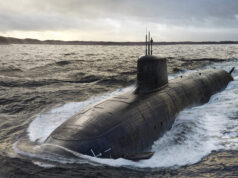A U.S. Navy destroyer took part an ‘Air Defence Live Fire Event’ off the Scottish coast in the form of ‘Live Fire with a Purpose’ to satisfy the intent of Theatre Certification requirements.
The destroyer was part of the US SIXTH Fleet, and was in UK waters undertaking Exercise Joint Warrior 20-2 – a UK hosted, multi-lateral training exercise designed to provide NATO and allied forces with a unique multi-warfare environment to prepare for global operations.

According to an e-mail received this morning from Qinetiq:
“To undertake the LFWAP activity, the ship broke away from the exercise on the UK East Coast and travelled to MOD Hebrides. Range capabilities at MOD Hebrides are provided through the Long Term Partnering Agreement (LTPA), a joint contract between QinetiQ and the MOD to deliver test & evaluation services across 16 core MOD sites in the UK.
The live fire exercise for the US SIXTH Fleet destroyer demanded a challenging tactical scenario with precise target specifications. The planning and execution of this project was achieved at very short notice by experts at MOD Hebrides. The range staff supported the exercise over three days in October, culminating in the successful intercept of a QinetiQ CATS (Combined Aerial Targets Service) supplied FireJet.”

The LFWAP event allowed the US naval crew to plan, train and execute a safe live firing and serves as a template for real world operational preparation. The crew benefitted from access to the MOD Hebrides range whilst in the UK.














Has anyone told Sturgeon?
Who???
ha ha :o)
So they used a SAM?
Looking at the above picture, those target drones are basically V1s. Yes I know they have software that enables them to simulate various attack profiles but they are do look remarkably similar.
They are…. and nothing like the latest Chinese/Indian/Russian stuff……..
Yea because these actually work. lol
Nope, nothing like a V1 which was basically a fire and forget, or spry and pay type of aircraft.
Any high Seas firing is a well planned and calculated event.
The target is launched and flies on a known flight plan.
The engagement is usually fairly straightforward and the target is not doing anything to taxing.
The High Seas firing is a system test not a tactical test. You take hard copy and electronic records from start to finish and analyse them, usually with an onboard quick look, followed by a detailed ashore assessment.
You will look at everything . Maintenance records and mod states. Missile batch numbers and time on board exposed to vibration etc. temp at launch, wind speed , humidity, sea state, will all be recorded.
They will data log Initial detection ranges and track extraction through onboard sensors and compare them to what the data loggers on the target are recording. The target position (Via GPS) is hopefully the same as the radar and track extractors report on the vessel. If they are not the same then there is a possible issue with radar accuracy.
When you shoot the data from the missile is again compared with target data logging. So Missile maneuvers and miss distances should be a match for the targets reporting systems. It’s not unheard of for a missile to explode and drop the target and still be assessed as a miss because the missile was not within the designed kill radius for the system.
That has happen to me a couple of times on Seawolf shoots. The engagement was spot on when we did the quick look data analysis , the missile exploded and dropped the target. However following shoreside detailed look the missile was a few feet outside of the designed kill radius and even though it did its job, it was assessed as a miss!
These type of shoots are expensive so the data obtained from them is trawed over in great detail. A Standard 2 or Standard 6 is going to cost between 2-4 mil each, the Target is probably half a mil. The manufacturers of the missile will want to know how it performed to ensure that they don’t have production/design issues. Radar manufacturers and Aegis software designers will want to know everything is working and no code glitches are evident.
When all is examined and you know your systems performed as advertised then you can be confident that they will perform as advertised when needed for real.
Wow. Thanks for that detailed information.